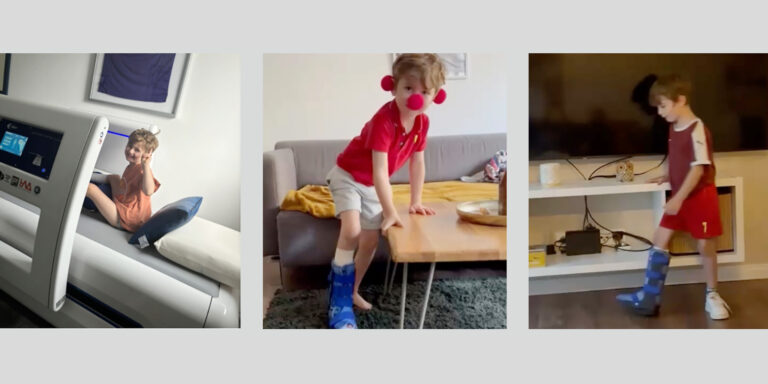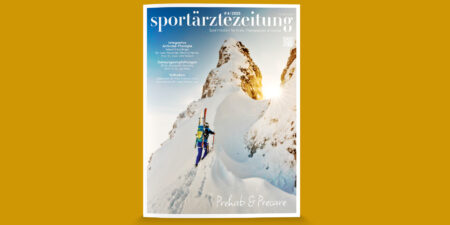In the last issue of sportärztezeitung, we published a detailed article on magnetic resonance therapy by PD Dr. med. Anna Schreiner and Prof. Dr. med. Götz Welsch. As announced, here are two specific cases involving MBST®therapy in a multimodal sports medicine setting by Peter Stiller, MedWorks Augsburg.
Case 1: Intraspongious calcaneal fracture in a professional soccer player
Medical history
This case involves severe bone marrow edema of the calcaneus with an intraspongious fracture and accompanying enthesopathy of the Achilles tendon in a 21-year-old U21 national player, caused by a massive blow during a league game on September 14, 2023. The player had to leave the game immediately and was unable to put weight on his heel. He was then treated with ice by the medical team and, due to the severe pain, was given an air walker and crutches to completely relieve the weight on his leg. Mobility in the ankle joint was unrestricted.
MRI findings
- Massive bone marrow edema in the rear heel bone → intraspongious fracture
- Signs of tendon attachment inflammation of the Achilles tendon
- Slight signs of plantar fasciitis at the heel bone attachment
- No injury to the tendons or ligaments
- Swelling in the joint and around the heel bone
A detailed clinical examination during the initial consultation on September 19, 2023 revealed the following findings: pronounced pressure pain in the heel bone area, mainly dorsal and plantar, with very pronounced soft tissue swelling around the calcaneus. DMS normal, no numbness, no dysesthesia. VAS with partial weight bearing in the AirWalker 3–4, VAS when attempting to roll off properly 8–9. Additional DS at the AS insertion and approx. 2 cm proximally with only minimal swelling here. No instability or signs of accompanying injury to the tendons or ligaments.
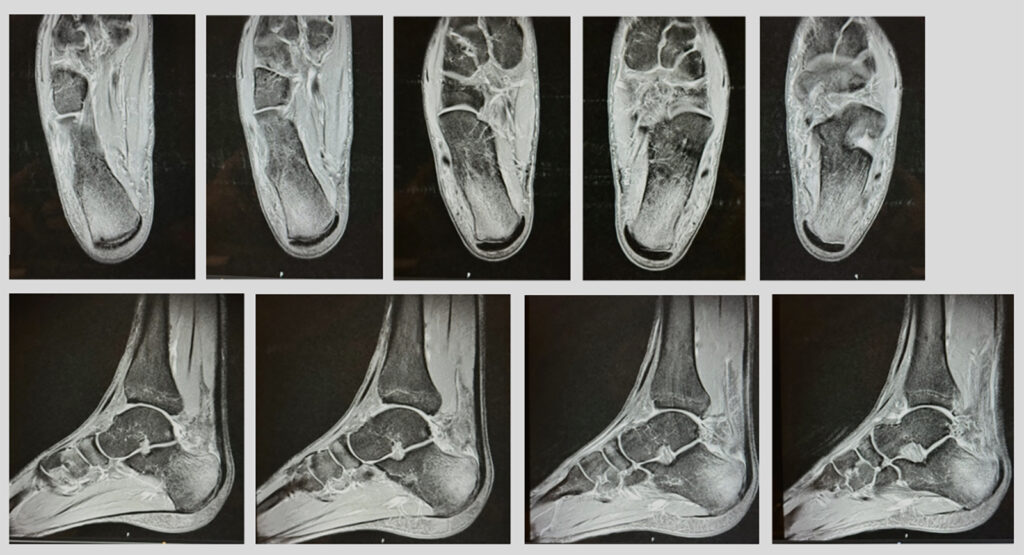
Treatment
Normally, further treatment at this stage would have consisted of a combination of anti-inflammatory medication (NSAIDs), further rest, cooling and relief, physiotherapy and magnetic field therapy. The player was expected to be out of action for 6–8 weeks. However, as we did not believe that these measures would have been sufficiently effective for a young professional soccer player and that prolonged immobilization would have led to muscle atrophy and further problems with the RTC, we decided, together with the player and his advisor, to opt for a regenerative combination therapy consisting of magnetic resonance therapy (MBST), radial and focused extracorporeal shock wave therapy (ESWT), high-energy laser therapy, hyperbaric CO2 cryotherapy, and cooling bandages. Magnetic resonance therapy was performed as a 9-session bone treatment program using an MBST Arthro Spin Flex device from MedTec GmbH, ESWT with an EMS DolorClast radial and focus device, and high-energy laser therapy with the EMS DolorClast Highpower laser. Hyperbaric CO2 cold therapy was performed with a Cryolight device (Elmako), and the cooling bandages were from MediVid Cryo.
In our opinion, the most effective sequence for these treatments is to start with high-energy laser therapy. This achieves its strongest pain-relieving effect after 60 minutes, which is why we treat patients with MBST immediately afterwards and then ESWT, which means that the pain relief provided by the laser and MBST can be treated with the maximum possible (patient-tolerable) working pressure and thus with the highest possible energy flux density. This is crucial for ESWT, as we know from the study by Zhang et al (2021, Journal of Rehabilitation Medicine) that the result depends directly on the amount of energy applied. Finally, we follow up with treatment using Cryolight, kinesio tape, and cold packs. To maintain physical fitness and performance during therapy, the patient also received IHHT (interval hypoxia-hyperoxia therapy), i.e., altitude training, using an airPoint altitude balance device. A combination of Wobenzym 3×4, vitamin D3+K2+magnesium 5000 IU daily and anthocyanins from wild blueberries was administered orally.
Progress
On the first day, we began with the above-mentioned therapies, whereby ESWT was only possible with a working pressure of 1.5 bar radially and an intensity of 2 focused. However, pain relief was extremely rapid, so that by day three the patient was able to walk without crutches and without pain under full load, and ESWT could be performed at 2.7 bar and Int. 7. After therapy on day 5 with ESWT 4.0 bar (maximum pressure for this device) and Int. 14, we cleared the patient for jogging due to complete freedom from symptoms. In consultation with our athletic trainer Martin Dorn from Friedberg (near Augsburg), it was then possible to increase the load extremely quickly, so that we were able to complete the therapy as planned on September 28, 2023, at our facility in Augsburg and send the player back to his club after careful consultation with the doctors, physical therapists, and athletic trainers. Our goal would have been a return to competition (RTC) around October 9 or 10, 2023. To our surprise, however, the player was back on the field for 90 minutes on October 3, 2023, and has been completely symptom-free in the affected area ever since, playing in every Bundesliga and U21 national team game.
CASE 2: Tibia fracture in a 5-year-old ice hockey player
Medical history
The present case involves a 5-year-old boy who suffered a tibial shaft fracture in the middle third while playing ice hockey and was subsequently treated only with painkillers (ibuprofen), an above-knee plaster cast, and complete rest. He was instructed not to put any weight on the leg under any circumstances so that the fracture could not shift. In addition, 5 X-rays were taken over a period of 4 weeks. Although the last X-ray taken on June 21, 2024 showed no signs of healing, this type of treatment was to be continued. When the young patient was presented to me after these four weeks, he had already developed a pain syndrome. The boy was in severe pain and was terrified of being touched or of putting any weight on his leg.
Findings
On June 21, 2024, a very anxious 5-year-old boy was presented, carried by his father because he was “not allowed to walk.” There was still slight swelling in the area of the fracture with severe pain on touch; walking was out of the question. Under really difficult examination conditions, it should at least be noted that there are no neurological abnormalities. Both ankles are open, like an ulcer, due to the friction caused by the splint. Here, too, there is very severe pain on any contact with the surrounding area.
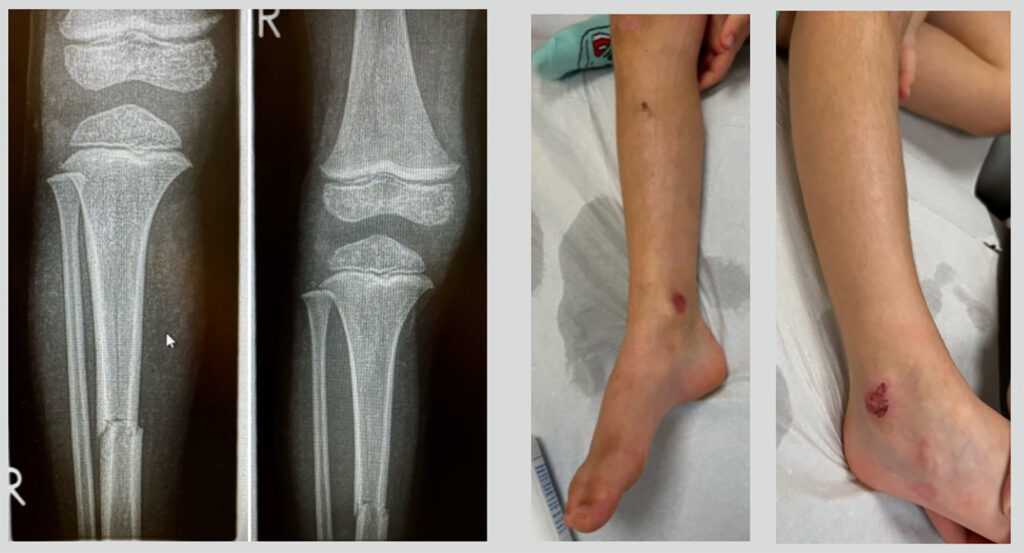
Treatment
Since the boy suffered such severe pain at the slightest strain or touch, the only option at first was a pain-free (and as quickly as possible pain-relieving) form of therapy. We therefore opted for magnetic resonance therapy (MBST), as this is pain-free and has no side effects, and often leads to rapid pain relief and a positive effect on bone metabolism and structure. Due to the severe pain and the unfortunate loss of trust in doctors, a very detailed therapy planning meeting was held (also supported by the help of three clown noses, see photo), so that we were finally able to start the MBST therapy on the same day (June 21, 2024). It should be noted here that this is always an off-label use in children, as magnetic resonance therapy is only officially approved for use in people aged 18 and over. However, from my own experience and other previous treatments, we know that MBST is not only free of side effects in children, but also effective and painless.
Accordingly, a very detailed consultation was held with our young patient and both parents prior to treatment, and their express wish for this treatment was documented in writing and signed by both parents. In addition, high-energy laser therapy and hyperbaric CO2 cryotherapy were added, as these can also be performed painlessly and have pain-relieving and anti-inflammatory effects.
The MBST was performed as a 9-session bone treatment program using the MBST Arthro Spin Flex device. All other therapies (ESWT, laser, cryo) were performed with the same devices and dressings as in case 1, except that in this case, focused ESWT was not used, as it has been scientifically proven that radial ESWT is just as effective as focused ESWT in cases such as pseudarthrosis when the fractures are superficial. Of course, we supplemented the boy’s diet with vitamin D3 and K2 (Natugena Lipo Vitamine Forte 1000, 1 tablet per day with a meal), omega-3 chewable drops (from Norsan) 3 per day, and Traumeel (Heel) 3 x 2 tablets.
Progress
These measures led to a very rapid improvement in symptoms. After just 3 days (i.e., after 3 MBST, laser, and cryotherapy), the boy was already able to take a few steps in the walker without pain. After 5 days in the walker, he was able to walk freely, and after 3 weeks, he was even able to play soccer again. After 5 weeks, he was back to playing ice hockey at full strength.
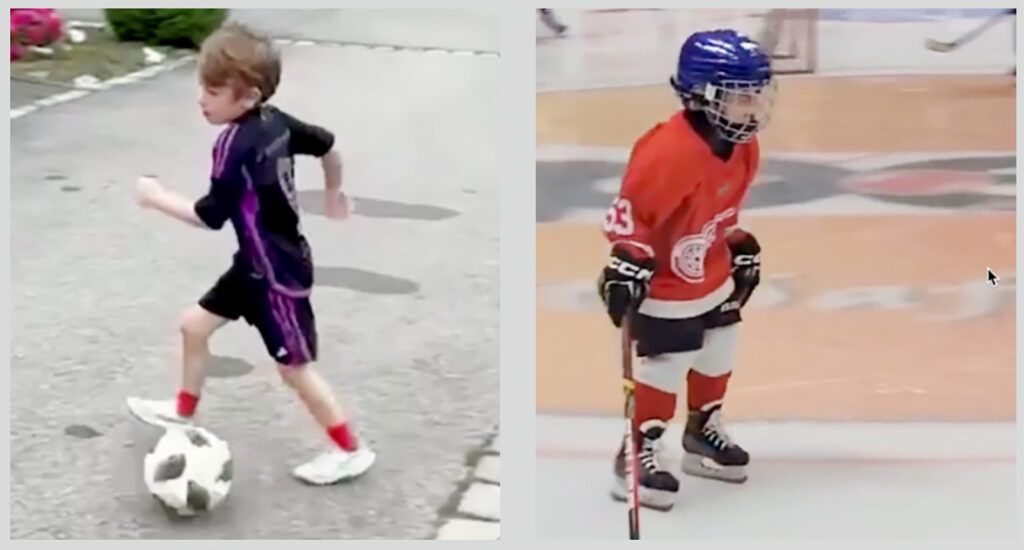
Conclusion
MBST is an effective, painless, side-effect-free, and perfectly combinable therapy option that has analgesic, anti-inflammatory, and regenerative effects in every single treatment.
The combination of MBST, shock wave therapy, high-energy laser therapy, modern, intensive cold therapy, and oral supplements tailored to the individual patient, such as vitamin D3 + K2, omega 3-FS, phytopharmaceuticals such as Phytoshake Berry Deluxe, enzyme combination therapy (e.g., Wobenzym) and Traumeel, even in cases with such pronounced findings and pain as in the two cases described above, very satisfactory, stress-resistant and rapid results can be achieved in terms of pain relief, healing and return to competition.
Outlook
In my opinion, magnetic resonance therapy (MBST) will play a much more important role in the future in individual, regenerative combination therapy for professional and amateur athletes, but also for children in particular. The possibilities offered by this pain-free and side-effect-free, yet highly effective treatment method are not even fully known yet.
Autoren
ist Facharzt für Allgemeinmedizin und Notfallmedizin in der Praxis Allgemeinmedizin Lechhausen & MedWorks – Privatärztliche Praxis, Augsburg. Er ist ehemaliger Mannschaftsarzt des Profiteams des FC Augsburg und wiss. Beirat der sportärztezeitung.
